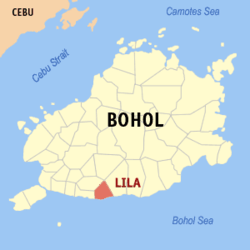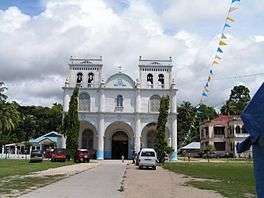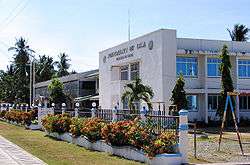Lila, Bohol
| Lila | |
|---|---|
| Municipality | |
|
Municipal building of Lila | |
 Map of Bohol with Lila highlighted | |
.svg.png) Lila Location within the Philippines | |
| Coordinates: 9°36′N 124°06′E / 9.6°N 124.1°ECoordinates: 9°36′N 124°06′E / 9.6°N 124.1°E | |
| Country | Philippines |
| Region | Central Visayas (Region VII) |
| Province | Bohol |
| District | 3rd district of Bohol |
| Incorporated | 1 January 1915 |
| Barangay | 18 (see § Barangays) |
| Government [1] | |
| • Type | Sangguniang Bayan |
| • Mayor | Regina Salazar (LP) |
| • Vice mayor | Arturo Piollo |
| • Town Council |
Members
|
| • Representative | Arthur Yap |
| Area[2] | |
| • Total | 40.5 km2 (15.6 sq mi) |
| Population (2015 census)[3] | |
| • Total | 12,257 |
| • Density | 300/km2 (780/sq mi) |
| • Voter (2016)[4] | 6,835 |
| Time zone | PST (UTC+8) |
| ZIP code | 6304 |
| IDD : area code | +63 (0)38 |
| Income class | 5th class |
| PSGC | 071227000 |
| Website |
www |
Lila is a 5th municipal income class municipality in the province of Bohol, Philippines. According to the 2015 census, it has a population of 12,257.[3] In the 2016 election, it had 6,835 registered voters.[4] Thirty kilometres (19 mi) from Tagbilaran, it is bound to the east by Dimiao, to the west by Loay and to the north by Loboc.
History
The coastal town of Lila once belonged to the Municipality of Dimiao. It was composed of the barrios of the municipalities of Loay and Dimiao. In 1899, during the Spanish–American War, the municipal building, the church and neighboring houses were razed to the ground and burned. Thus, no records can be shown stating when Lila was annexed to the town of Dimiao. However, the Agustinian mission in Bohol has written that Lila was a separate municipality in 1879, with a population of 4,023.
Later, a town was founded and part of the municipality was annexed back to Loay and part to Dimiao. From that time up to 1914, the municipal government of Lila ceased to function.
However, in 1915 the municipality of Lila was re-established. That part of Lila annexed to Dimiao and those annexed to Loay were returned and formed the new municipality of Lila.
For the church, it was initially administered alternately by a priest stationed in Loay and Dimiao due to the scarcity of priests. It was only in 1921 that the priest of Lila had a residential parish. The church and the convent built then were only made of light materials.
In 1915, during the administration of Fr. Narciso Maglasang, the present church was built. The convent was constructed under the administration of Fr. Miguel Ortega some time in the year 1941.
After World War II, the town prospered.
Barangays
Lila comprises 18 barangays, of which 10 are coastal and 8 inland:
| PSGC | Barangay | Population | ±% p.a. | ||
|---|---|---|---|---|---|
| 2015[3] | 2010[5] | ||||
| 071227001 | Banban | 7.9% | 967 | 918 | +1.00% |
| 071227002 | Bonkokan Ilaya | 5.4% | 660 | 691 | −0.87% |
| 071227003 | Bonkokan Ubos | 6.4% | 788 | 775 | +0.32% |
| 071227004 | Calvario | 7.8% | 959 | 919 | +0.81% |
| 071227005 | Candulang | 3.1% | 384 | 378 | +0.30% |
| 071227006 | Catugasan | 3.3% | 408 | 431 | −1.04% |
| 071227007 | Cayupo | 1.8% | 223 | 214 | +0.79% |
| 071227008 | Cogon | 3.9% | 480 | 460 | +0.81% |
| 071227009 | Jambawan | 4.9% | 605 | 575 | +0.97% |
| 071227010 | La Fortuna[lower-alpha 1] | 5.7% | 700 | 677 | +0.64% |
| 071227011 | Lomanoy | 4.8% | 591 | 616 | −0.79% |
| 071227012 | Macalingan | 4.6% | 568 | 558 | +0.34% |
| 071227013 | Malinao East | 6.9% | 842 | 800 | +0.98% |
| 071227014 | Malinao West | 1.9% | 230 | 243 | −1.04% |
| 071227015 | Nagsulay | 8.7% | 1,070 | 1,031 | +0.71% |
| 071227016 | Poblacion | 9.7% | 1,195 | 1,163 | +0.52% |
| 071227017 | Taug[lower-alpha 1] | 5.2% | 642 | 635 | +0.21% |
| 071227018 | Tiguis | 7.7% | 945 | 901 | +0.91% |
| Total | 12,257 | 11,985 | +0.43% | ||
Demographics
| Population census of Lila | |||||||||||||||||||||||||
|---|---|---|---|---|---|---|---|---|---|---|---|---|---|---|---|---|---|---|---|---|---|---|---|---|---|
|
| ||||||||||||||||||||||||
| Source: Philippine Statistics Office[3][5][7] | |||||||||||||||||||||||||
In the 2016 election, it had 6,835 registered voters, meaning that 56% of the population are aged 18 and over.[4]
Gallery
- Elementary school in Poblacion, Lila
 Catholic Church
Catholic Church.jpg) Lila Church ceiling
Lila Church ceiling
Notes
References
- ↑ "Municipality". Quezon City, Philippines: Department of the Interior and Local Government. Retrieved 31 May 2013.
- ↑ "Municipal: Lila, Bohol". PSGC Interactive. Quezon City, Philippines: Philippine Statistics Authority. Retrieved 8 January 2016.
- 1 2 3 4 "Region VII (CENTRAL VISAYAS)". Census of Population (2015): Total Population by Province, City, Municipality and Barangay (Report). PSA. Retrieved 20 June 2016.
- 1 2 3 "2016 National and Local Elections Statistics". Commission on Elections. 2016.
- 1 2 "Region VII (CENTRAL VISAYAS)". Census of Population and Housing (2010): Total Population by Province, City, Municipality and Barangay (Report). NSO. Retrieved 29 June 2016.
- ↑ Republic Act No. 1688 of 20 June 1957 An Act Converting the Sitio of Taug Norte, Barrio of Taug, Municipality of Lila, Province of Bohol, into a Barrio of Said Municipality to Be Known As the Barrio of La Fortuna.
- ↑ "Region VII (CENTRAL VISAYAS)". Census of Population (1995, 2000 and 2007): Total Population by Province, City and Municipality (Report). NSO. Archived from the original on 24 June 2011.
External links
| Wikimedia Commons has media related to Lila. |
 |
Loboc |  | ||
| Loay | |
Dimiao | ||
| ||||
| | ||||
| Bohol Sea |
